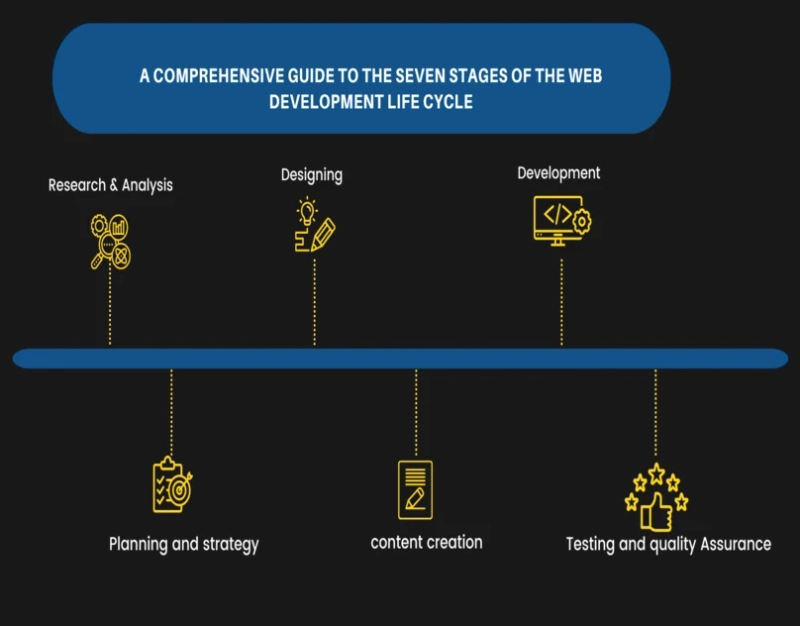Creating websites and web apps that function online are known as web development. A content management system and a full-fledged, complex web application can be created, as well as a straightforward static one-page website.
The website development life cycle of software includes:
The logic coded into the applicationUsing databases and handling user queriesCreate user interfacesUsing servers to host the website
Server-side, client-side, and full-stack development can be used to categorize each step in creating a custom online application.
Web development life cycle
An entire website's life cycle, from the idea's conception through the coding and design to the deployment and maintenance, is referred to as the web development life cycle. This is the prescribed or methodical procedure to build a website that works well.
It provides a simple summary of the software development life cycle that a full stack developer and project manager can use to achieve minimal errors and ideal outcomes.
Stages of the web development cycle
Research and Analysis
This important stage of web development is typically overlooked. It's imperative to learn as much as possible about the project and the client to ensure your design and development are going in the appropriate direction.
Your developers won't be able to offer the best solution if they don't know what they are working toward and what the requirements are.
It's crucial to picture the demographics of the visitors your website will serve throughout this time. Set objectives and create requirement elicitation documents while considering each person's age, gender, interests, and needs. Surveying users to learn about the issues they are having, and the solutions they are looking for frequently pays off.
You must evaluate the viability and profitability of your ideas for web applications.
The remaining stages of web development become irrelevant and unable to deliver the required results if this step is skipped.
Planning and strategy
The strategy for the website's development includes planning its marketing, design, technology, and content. Informed choices are made regarding the website's layout and functionalities based on the data acquired and examined in the previous step.
A committed team is established during the planning phase, and each member is given a specific role and task assignment.
Before building a website, it's crucial to choose the technology stack, software development methodology, and content organization (including wireframes, schematics, and rough designs).
The programming languages, web frameworks, and software components that make up the technology stack are utilized to create any type of web application.
The Planning phase also involves allocating resources, establishing deliverables, estimating timescales, and creating a sitemap. Before moving on to the Design step, you must finally settle on the branding of your website.
Designing and wireframing
The UI-UX designers come to the fore during the web design stage, which entails designing the layout of websites.
The layout entails creating a quick sketch, which could be graphical, to obtain a sense of the website's style. The layout's objective is to create an informational framework so your clients can take a visual tour of the base features and content.
The wireframe created in the previous step is translated into buttons, tabs, menus, dashboards, color schemes, typography, and graphics to develop the website's basic structure.
Create an interactive website that satisfies their tastes and needs while keeping the target audience in mind. Don't let your website or application lapse into indifference.
Content creation
The ultimate winner is content. No amount of beautiful design can help you if you can't connect with your readers and customers. The purpose of the content generation phase is primarily to establish a communication channel via the user interface.
In content writing, pertinent information about your business is presented clearly, and engagingly. Throughout the web development lifecycle, calls to action are added, creative headlines are written, and formatting, line editing, composing, and updating texts are all done.
The branding and marketing of your website or web app are developed at this phase, and you can define the goals of your website by creating content.
Code and development
The actual construction of the website is done during the development phase. In this stage, the client-side and server-side development of the website is completed. It takes up the most time during the website creation process.
Testing (Quality Assurance)
A thorough test is carried out after the website is established to eliminate any flaws. In order to thoroughly test the functionality, usability, compatibility, and performance of the web app, the QA team repeatedly employs testing techniques like unit testing, stress testing, integration testing, and load testing.
In order to create a website that works properly and offers a seamless user experience, project consistency is crucial. It is also vital to test how well each feature functions across all hardware and software.
Configuration and Upkeep
Your website or application will be prepared for launch once the QA team has approved it. The app is accessible to viewers using the File Transfer Protocol and is hosted on web servers.
The job is not done yet, though. You can determine where improvements are needed based on ongoing user feedback. This leads to executing the web application development life cycle to make the required alterations.
In addition, ongoing upkeep and upgrades are essential for maintaining the site's flawless performance and attracting new visitors. The day-to-day upkeep of your website may frequently fall under your purview if you hire a web development firm or bespoke website developers.
Web application development is a complicated process that necessitates following a specific set of steps in order to achieve satisfactory results. You can adjust the web development method to your project management strategy. However, gathering relevant data and adequate planning are essential for any website development project. Want to learn full stack development tools? Check out the popular full stack developer course and become a certified web developer in top MNCs.
0


